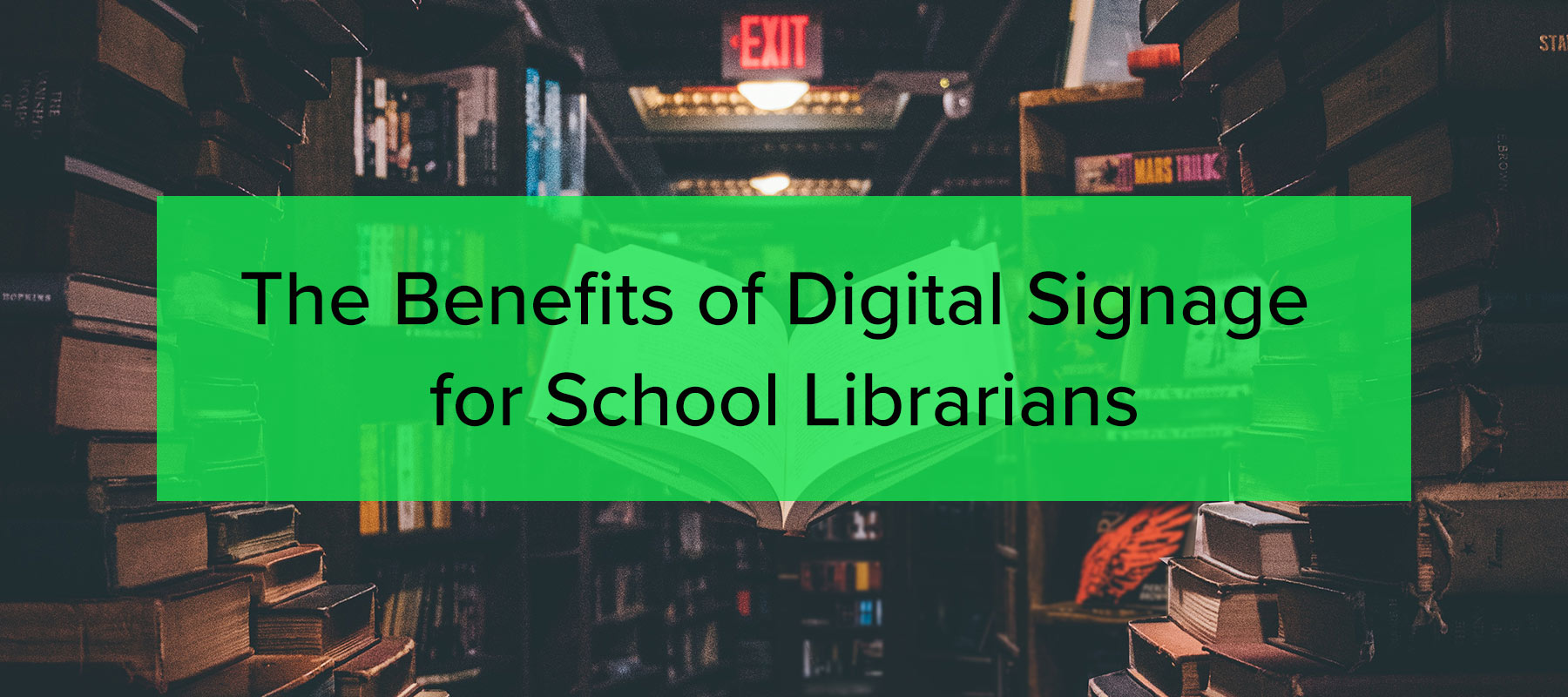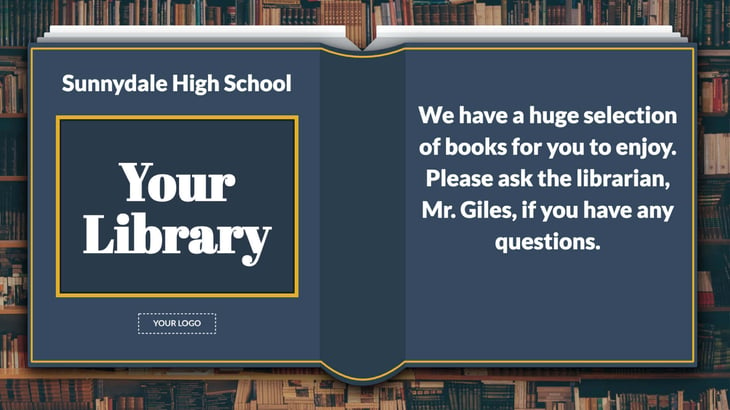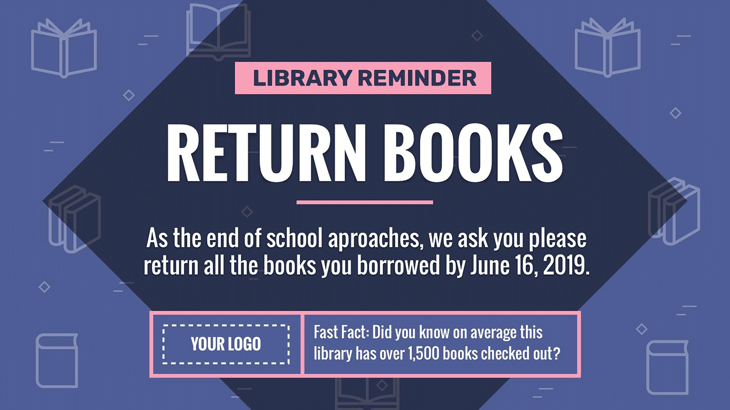
Digital signage is increasingly commonplace in schools as elsewhere. Librarians can get good results with even minimal digital signage, and you can do it with less effort than traditional signage.
In this post, we’ll go deeper into what digital signage is and what it can do, as well as how librarians can use it to help guide student behavior, encourage a positive view of libraries and reading, and improve links between what happens in the library and what happens in the classroom, the corridor, and the rest of the school.
Let’s start at the beginning.
Digital signage 101
Digital signage is signage shown on digital displays. That covers a lot of ground. There’s a huge range of different types of signage available, involving different types of displays, players, and software. For an overview of how a digital signage solution is put together, see this page.
What’s more important than the screens you use is what goes on behind them. Once the displays you’re using are as good as standard flatscreen TVs, the software and player you’re using matter a lot more. These are the components that dictate how much control you’ll have over your digital signage.
In general, there are three types of digital signage setup:
The most basic digital signage implementation isn’t controlled centrally. You might have two or three screens, each displaying content from thumb drives that staff have to carry around, transfer new content to, and keep track of. This type of arrangement has obvious drawbacks, but it also has obvious benefits: it still lets you access the advantages of displaying digital content, and it lets you refresh the content you display daily.
The next step up in sophistication is digital signage that’s centrally controlled, with each screen showing the same content. That’s a step up from having just a handful of screens — you can use simple, generally-applicable signs schoolwide. But you lose something in the process: the ability to talk directly to audiences based on what they’re doing and where they are. More timely or targeted messages are more effective and scattergun communication tends to miss more often.
A complete digital signage solution gives you control over what each screen shows and when. You might have a screen outside the gym, for example: knowing the school’s timetable, you can arrange to show content that’s relevant to the boys’ basketball team while they’re heading in to warm up, then in the afternoon show the dance club different content that’s tailored to their interests and the way they prefer to consume content.
In a lot of schools, there’s already a digital signage solution in play. The objective is to either get it extended into the library, or to make the best possible use of it once it’s there.
Advantages of digital signage
Traditional signage is static. It doesn’t move from second to second, or from day to day. Let’s take the second point first. You have to have a range of signs for different occasions, and many can be re-used — but between uses, they just gather dust. Soon, they look old-fashioned.
Every time you re-use them you have to find them, set them out, put the others away. It’s laborious and time-consuming. But you have to do it, unless you want the Thanksgiving signs still up at Easter. There’s the additional drawback that you can’t create signage quickly if things change quickly. You have to get out your markers or fire up your desktop publishing program, and like so many jobs in a school, you have to do it in between all the other things that need doing.
Traditional signage also stays static across the few seconds when people are actually looking at it, and that’s more important, if anything. Because we’re surrounded by static signage every day, we learn to filter it out. If it’s familiar, the effect is more pronounced. Static signage may as well not be there.
Digital signage is another story. It captures around five times as much attention as static signage, and improves retention by between 13% and 41%. It doesn’t just get more views: it affects behavior more. When digital signage is used, people pay attention.
As media specialist teacher Tony Smodilla told us, when he uses digital signage, ‘there's a lot of engagement with the students and the staff. When we built our building about 20 years ago, each classroom had it, and they would see our TV in it. So I'm also able to push out a presentation to those classroom TVs because I can control those TVs remotely… So I have a small presentation that I put in every classroom. We have a lot of pictures that people take of the staff taking our students doing activities like a science experiment or something in gym class. So on the classroom televisions, I push those pictures out, and it just rolls throughout the day.’
Why move digital signage into the library?
Isn’t the library supposed to be a place to concentrate? We all have the mental image of being told to shush in libraries because people are trying to read weighty tomes. And most libraries do need a quiet zone for that type of work. But libraries are also where people come to:
- Discover and pursue reading for pleasure
- Talk about books, reading, studying, and their school subjects
- Learn research techniques
- Use computers and access the internet
- Listen to music and other recorded sounds
- Watch movies
- Do homework, with or without friends
… and this is only a partial list. Libraries are a lot more than a stack of books and a ‘no talking’ sign.
School or district-wide digital signage solutions can use global messaging, where the same messaging is shown across the network. When that happens, it’s often messaging that’s appropriate no matter the age group, time or situation; otherwise, propagating it across the whole school wouldn’t make a lot of sense. This will typically be a ‘general announcement’ board, with a static message that’s usually school branding accompanied by an embedded news feed or social media feed. It’s a very efficient way to deliver a mix of messaging to a mixed audience. What place does it have in a library?
Libraries still need the kind of messaging that encourages students to identify with the school, which in turn helps nudge them toward pro-social behaviors. Those behaviors are as appropriate for the library as they are for the corridor or the classroom: respect for other students, calm, concern for the school environment. Students in the library still need to see the same announcements of school events and other whole-school messaging.
Library-only solutions
Fragmented solutions that involve using thumb drives or off-label consumer-grade software tools can be used in ways that are specific to the library. Whenever we use digital signage, we’re trying to:
- Provide information that we think our audience wants or needs
- Encourage behavior that we think will be good for them and us
These aren’t either-or; in many cases we’re trying to achieve both aims at the same time. For example, when you tell kids that a new installment of a long-running young-adult book series is out and the library has a copy, you’re informing them. At the same time, you’re also seeking to encourage them in the habit of reading for pleasure. That’s important, because it helps them acquire the comprehension and analysis skills that underlie so many other educational goals.
Some libraries have single isolated screens, managed by library staff with little input from school leadership, and not connected to a wider digital signage solution. This bare-minimum approach is far from optimal, but you can still:
- Announce which in-demand titles have been returned and are now available
- Remind students how long they can keep books out for
- Remind students of the rules and time limits that apply to computer use
- Announce library-related events — from spelling bees to study groups
- Recommend books to students based on what they like — students who like The Hunger Games might like to know there’s a new Suzanne Collins novel set in the same fictional universe; Harry Potter fans might want to give Ursula K. Le Guin a try
- Showcase research techniques, like how to use an index, cite a source, or where books on certain subjects are kept
- Room availability if there are meeting, study or breakout rooms
(Obviously, some of these are more suitable for some age groups than others.)
You can also share age-appropriate historical or current events facts, though it’s best to tread carefully and keep clear of contentious subjects.
However, all these approaches have significant downsides.
Complete signage solutions
What librarians really need, no less than others in the school, is a schoolwide digital signage solution that’s also sufficiently granular that they can push different messaging to different screens at different times. This solution should be sufficiently modular that it can be built piecemeal, using screens you already have or that can be sourced easily.
When you can schedule content for different screens at different times, you can plan for the year in advance. Seasonal holidays and student requirements, like the first day back or the run-up to graduation, can be prepared months in advance, scheduled, and left to run.
The key to assembling content in advance and to being able to cope with the unexpected is templates. Rise Vision uses an ever-expanding library of templates ranging from the highly-specific…

Get started with this Halloween-themed digital signage template here.
…to the extremely nonspecific:

Get started with this versatile digital signage template here.
This versatility and range lets you choose where to dedicate efforts, and allows you to be both prepared and responsive.
There’s a central control dashboard and slide editor, and you can schedule content for the year in advance, then manage it on the fly from any connected device.
Focusing complete signage solutions on the library
What if you’re a librarian in a school with just one or two screens and you’re looking for a way to use digital signage? You can start taking advantage of Rise Vision’s library-specific templates right away(Also check out these library digital signage ideas for your school).
Use a default template to show news and events when there’s no more pressing issue:

Get start with this digital signage template here.
Using quotes from books students may be familiar with from their own self-directed reading can help make the library feel welcoming and inclusive; students are seeing their own cultural values and interests reflected back at them.

Get started with this digital signage template here.
Quotes from classics can help demystify them, and bring students sooner to the realization that there’s value in Shakespeare and Austen, Baldwin and Lee.
You can use action-specific templates like this one to encourage the right choice, in the right place — put this near the exit to the library so students are reminded. If you have a school-wide digital signage system, you can arrange to have content like this shown in classrooms or corridors too.

Get started with this digital signage template here.
Signage becomes a tool you can use to drive behaviors that take legwork off your desk: instead of chasing overdue books you can focus on activities that deliver more value to the library, the students and the school.
Conclusion
Digital signage is a natural fit for the school library. It knits the library closer into the life of the school and helps students to feel welcome in it and responsible for it. Librarians can prepare in advance and still respond quickly to changing circumstances.
Complete digital signage solutions offer templates, centralized management, scheduling and granular control of individual screens. Librarians can use them to address the needs of different student groups and push relevant library-specific messages around the school. Most importantly, such a tool gives librarians a way to communicate that actually works and takes hours of repetitive effort off your desk for good.
We have also covered the benefits of digital signage for other roles. Feel free to view these articles below:
- The Benefits of Digital Signage for School Principals
- The Benefits of Digital Signage for Marketing Communications
- The Benefits of Digital Signage for School IT Staff





